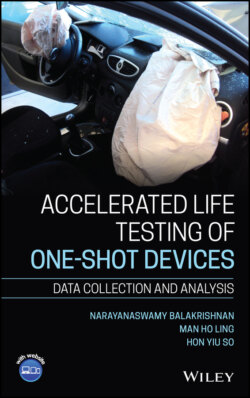Читать книгу Accelerated Life Testing of One-shot Devices - Narayanaswamy Balakrishnan - Страница 14
1.3 Accelerated Life‐Tests
ОглавлениеAs one‐shot devices (such as ammunition or automobile airbags) are usually kept for a long time in storage and required to perform its function only once, the reliability required from such devices during their normal operating conditions would naturally be high. So, it would be highly unlikely to observe many failures on tests under normal operating conditions within a short period of time. This renders the estimation of reliability of devices to be a challenging problem from a statistical point of view. In this regard, ALTs could be utilized to mitigate this problem. In ALTs, devices are subject to higher‐than‐normal stress levels to induce early failures. In this process, more failures could likely be obtained within a limited test time. As the primary goal of the analysis is to estimate the reliability of devices under normal operating conditions, ALT models would then typically extrapolate (from the data obtained at elevated stress levels) to estimate the reliability under normal operating conditions. ALTs are known to be efficient in capturing valuable lifetime information, especially when there is a need to shorten the life‐testing experiment. For this reason, ALTs have become popular and are commonly adopted in many reliability experiments in practice. One may refer to the detailed reviews presented by Nelson (1980), Cramer and Kamps (2001), Pham (2006), and Meeker and Escobar (2014), and the excellent booklength account provided by Nelson (2009).
Constant‐stress accelerated life‐tests (CSALTs) and step‐stress accelerated life‐tests (SSALTs) are two popular ALT plans that have received great attention in the literature. Under a CSALT, each device gets tested at only one prespecified stress level. To mention a few recent works, for example, Wang et al. (2014) considered CSALTs with progressively Type‐II right censored samples under Weibull lifetime distribution; for pertinent details on progressive censoring, see Balakrishnan (2007) and Balakrishnan and Cramer (2014). Wang (2017) discussed CSALTs with progressive Type‐II censoring under a lower truncated distribution. Lin et al. (2019) studied CSALTs terminated by a hybrid Type‐I censoring scheme under general log‐location‐scale lifetime distributions. SSALTs are an alternative to apply stress to devices in a way that stress levels will increase at prespecified times step‐by‐step. For SSALTs, there are three fundamental models for the effect of increased stress levels on the lifetime distribution of a device: The tampered random variable model proposed by DeGroot and Goel (1979), the cumulative exposure model of Sedyakin (1966) and Nelson (1980); see also (Nikulin and Tahir, 2013), and the tampered failure rate model proposed by Bhattacharyya and Soejoeti (1989). All these models of SSALTs have been discussed extensively by many authors. Gouno (2001) analyzed data collected from SSALTs and presented an optimal design for SSALTs; see also Gouno (2007). Zhao and Elsayed (2005) analyzed data on the light intensity of light emitting diodes collected from SSALTs with four stress levels under Weibull and log‐normal distributions. For the case of exponential lifetime distribution, by considering a simple SSALT under Type‐II censoring, Balakrishnan et al. (2007) developed exact likelihood inferential methods for the model parameters; see also Balakrishnan (2008) for details, while Xiong et al. (2006) considered the situation when the stress changes from a low‐level stress to a high‐level stress at a random time.
